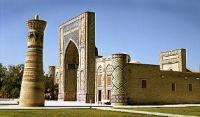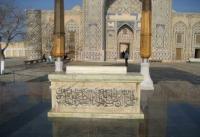Вы здесь
Gijduvani Memorial Complex.



Bukhara province in history of the Great silk.
«Memory is the treasure house of the mind wherein the monuments thereof are kept and preserved»
Thomas Fuller.
Popular destinations to Bukhara.
The land of Bukhara keeps the ashes of many great figures of Islamic culture. Among them is such an iconic person as the outstanding Sufi Abd al-Khaliq Gijduvani (died 1180/1220). He was born and died in the village of Gijduvan near Bukhara.
Al-Gijduvani was a student of the famous sheikh Yusuf al-Hamadani and the founder of the Central Asian Sufi school "Hajagan" ("the way of teachers"). The followers of the Hajagan tradition were the Bukharian Sufis Amir Kulal and Baha ad-Din Naqshband, who gave rise to the teachings of Naqshbandiya.
In 1432 - 1433 Next to the burial of Sheikh al-Gijduvani, the ruler of Maverannakhr Mirzo Ulugbek (1409-1449) built a small one-story madrasah with a portal facing east. By area, it is four times smaller than the Ulugbek madrasa in Samarkand.
At the entrance to the madrasa of Ulugbek there is a small minaret, similar to the minaret of Kalyan. At the beginning of the XXI century, a modern memorial to Abd al-Khalik Gijduvani was built in Gijduvan. It is an exquisite wooden iwan on ten pillars with a blue dome, under which is the tombstone of Sheikh al-Gijduvani.
The full name of the holy feast is Khoja Abd al-Khaliq Abd al-Jamil Gijduvani. His grave is located in the village of Gijduvan in the Bukhara region. He was born in 1118, when Islam, as a religion, already fully mastered the minds of the inhabitants of the cities and villages of Maverannahr, and Bukhara acquired the status of the recognized capital of the followers of the Prophet Muhammad throughout Central Asia.
Abdulhalik was born into a deeply religious Islamic family and from early childhood was surrounded by the rites and mystery of Islam. His father was the imam of the mosque. By the age of nine, Abdulhalik knew by heart the main book of the Muslims - the Koran.
Such a boy's desire for scripture was a natural need of his developing spirit. From the age of ten he takes an active part in the joy of the dervishes, but after talking with them for about three years, he comes to understand that to improve the spirit in this environment enough true knowledge. And Abdulhalik goes to Bukhara.
During this period, mosques and madrasas were actively built in Bukhara. The city was ruled by the Karakhanids, whose rulers generously patronized Islam. In Bukhara there were many extensive libraries where rare manuscripts in Arabic, Persian, Turkic, and Uygur languages were kept.
These were works on history, Islamic sciences, literature, philosophy, astronomy, medicine, and a whole series of exact sciences. Abdulhalik, without interrupting the friendship with dervishes and young Sufis, I eagerly plunged into the world of books, into the world of knowledge.
In Bukhara, he met with the sheikh of Abu Yakub Yusuf al-Hamadani, famous throughout the East, and soon became his most beloved disciple.
Authority:
V.G Saakov «History of Bukhara». Publishing house "Shark", 1996. «Bukhara. Masterpieces of the Central Asia». The historical guidebook across Bukhara. 2012. "Bukhoro. Bukhara" In the Uzbek, English and Russian languages. Publishing house "Uzbekistan", Tashkent 2000. Mukhammad Narkshakhi. History of Bukhara. Tashkent. 1897 (translator N.Lykoshina). V.G.Saakov "Architectural masterpieces of Bukhara. A Bukhara regional society "Kitabhon" Uzbek SSR, Exactly 1991 Robert Almeev. "History of ancient Bukhara". (Under edition of the Academician of the Academy of sciences of Republic Uzbekistan of Rtveladze E.V.).







